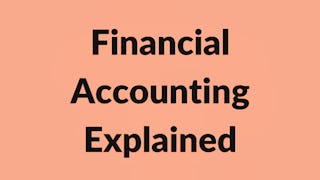This course presents an introduction to financial statement analysis and its usage when assessing business performance. The first part of the course will focus on understanding the most important financial statements, namely, the balance sheet, the income statement, and the statement of cash flows. We will then focus on how we can understand the financial health and performance of the company by examining a number of important financial ratios that are derived from the financial statements of the company. Finally, we will be able to understand business performance across years comparing main results and indicators extracted from financial statements. Lectures on concepts will be supplemented with numerical examples and suggested readings.



Financial Accounting
This course is part of Data & Finance for the future Specialization

Instructor: Felipe Garrán
Included with 
Recommended experience
Recommended experience
What you'll learn
Interpret the main financial statements and reports
Understand business performance across time
Evaluate company results and peer comparison
Use financial ratios to diagnose the company's economic status
Skills you'll gain
Details to know

Add to your LinkedIn profile
17 assignments
See how employees at top companies are mastering in-demand skills

Build your subject-matter expertise
- Learn new concepts from industry experts
- Gain a foundational understanding of a subject or tool
- Develop job-relevant skills with hands-on projects
- Earn a shareable career certificate


Earn a career certificate
Add this credential to your LinkedIn profile, resume, or CV
Share it on social media and in your performance review

There are 5 modules in this course
In week1, we will cover an introduction to the balance sheet as business’ picture, focusing on accounting and its users and how a balance sheet is built. Next, we go on to understand the income and cash flow statements as business movies focusing on their principal accounts. Finally, we integrate the 4 statements using a restaurant as example.
What's included
8 videos5 readings5 assignments1 plugin
In week 2, we will cover: company’s financial condition and performance across time (horizontal analysis) and to a base amount (vertical analysis); margin – a profitability measure; EBIT and EBITDA (the income provided by the company’s business, the operating result); net income (the results for the company's shareholders); tax shield.
What's included
8 videos4 assignments
In week 3 we will better understand the balance sheet and important analyses we can perform with its data: liquidity ratios; receivables and inventories ratios; operational and financial liabilities; working capital; and cash cycle.
What's included
7 videos4 assignments
In week 4 we will discuss cash flow analysis, covering: cash flow from operations; cash flow from investing; cash flow from financing.
What's included
6 videos4 assignments1 plugin
In week 5 we will put everything together and perform a step-by-step analysis.
What's included
9 videos2 readings
Instructor

Offered by
Explore more from Finance


University of Virginia


Duke University


Coursera Project Network


University of California, Irvine
Why people choose Coursera for their career




New to Finance? Start here.

Open new doors with Coursera Plus
Unlimited access to 10,000+ world-class courses, hands-on projects, and job-ready certificate programs - all included in your subscription
Advance your career with an online degree
Earn a degree from world-class universities - 100% online
Join over 3,400 global companies that choose Coursera for Business
Upskill your employees to excel in the digital economy
Frequently asked questions
Access to lectures and assignments depends on your type of enrollment. If you take a course in audit mode, you will be able to see most course materials for free. To access graded assignments and to earn a Certificate, you will need to purchase the Certificate experience, during or after your audit. If you don't see the audit option:
The course may not offer an audit option. You can try a Free Trial instead, or apply for Financial Aid.
The course may offer 'Full Course, No Certificate' instead. This option lets you see all course materials, submit required assessments, and get a final grade. This also means that you will not be able to purchase a Certificate experience.
When you enroll in the course, you get access to all of the courses in the Specialization, and you earn a certificate when you complete the work. Your electronic Certificate will be added to your Accomplishments page - from there, you can print your Certificate or add it to your LinkedIn profile. If you only want to read and view the course content, you can audit the course for free.
If you subscribed, you get a 7-day free trial during which you can cancel at no penalty. After that, we don’t give refunds, but you can cancel your subscription at any time. See our full refund policy.
More questions
Financial aid available,

